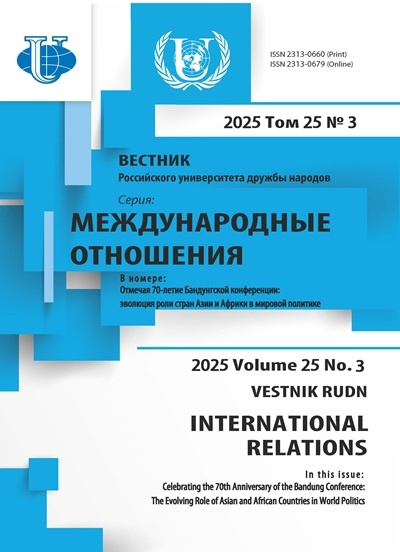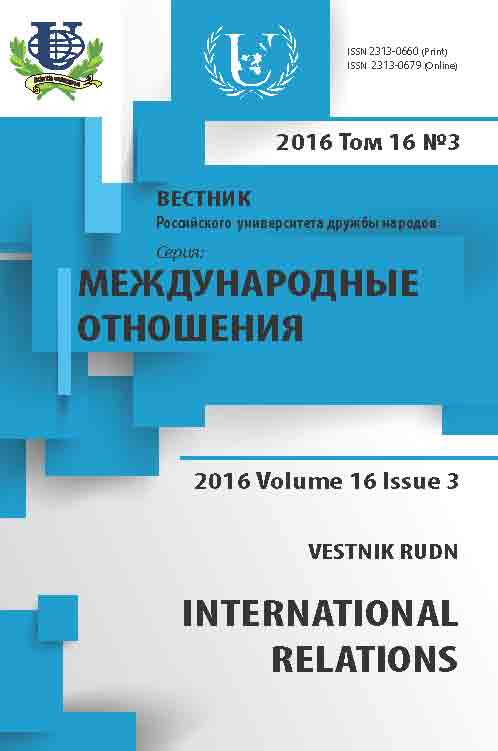Современный военно-силовой контртерроризм: международно-политический и правовой аспекты
- Авторы: Громогласова Е.С.1
-
Учреждения:
- Институт мировой экономики и международных отношений имени Е.М. Примакова Российской академии наук
- Выпуск: Том 16, № 3 (2016): Международные конфликты: Quo Vadis?
- Страницы: 426-436
- Раздел: СТАТЬИ
- URL: https://journals.rudn.ru/international-relations/article/view/14761
- ID: 14761
Цитировать
Полный текст
Аннотация
Статья оценивает практику военно-силовых ответов на вызов международного терроризма с точки зрения ее соответствия принципам международного права. Показано, что риски незаконного использования силы в контртеррористических операциях возникают в связи с расширением трактовки понятия «самооборона». Но несмотря на потенциал межгосударственной конфликтности, который несут в себе операции, проводимые на территории третьей страны без согласия ее правительства, военная сила продолжает утверждаться в качестве допустимой формы ответа на террористический вызов. В заключительной части статьи рассматриваются вопросы соблюдения международного гуманитарного права (МГП) в военных антитеррористических операциях. Также в работе трактуются нормы jus ad bellum и их место в системе Устава ООН. В результате автор приходит к заключению, что «криминализация» гуманитарной деятельности остается одним из серьезных вызовов, порожденных террористическим насилием во внутренних вооруженных конфликтах, и государствам и гуманитарным акторам еще только предстоит прийти к взаимоприемлемому компромиссу по разрешению этого вопроса.
Об авторах
Елизавета Сергеевна Громогласова
Институт мировой экономики и международных отношений имени Е.М. Примакова Российской академии наук
Автор, ответственный за переписку.
Email: e_gromoglasova@imemo.ru
Москва, Россия
Список литературы
- Кашников Б.Н. Частные военные компании и теория справедливых войн // Российский научный журнал. 2011. № 20. С. 83-94
- Русинова В.Н. Проблемы регулирования статуса «незаконных комбатантов» в международном гуманитарном праве // Вестник РГУ им. И. Канта. 2008. Вып. 9. Экономические и юридические науки. С. 19-27
- Фархутдинов И.З.(a) Международное право и доктрина СШАопревентивной самообороне // Евразийский юридический журнал. 2016. 2(93). С. 23-31
- Фархутдинов И.З.(б) Международное право о самообороне государств // Евразийский юридический журнал. 2016. 1(92). С. 91-100
- Bellamy A.J. Ethics and Intervention: The ‘Humanitarian Exception’ and the Problem of Abuse in the Case of Iraq // Journal of Peace Research. 2004. 41(2). P. 131-147
- Bellamy A.J. Is the War on Terror Just? // International Relations. 2005. 19 (3). P. 275-296
- Bellamy A.J. Just Wars: From Cicero to Iraq. 1st edition. Cambridge: Polity, 2006
- Bergesen A.J., Lizardo O. International Terrorism and the World System // Sociological Theory. 2004. 22 (1). P. 38-52
- Carswell A.J. Classifying the conflict: a soldier’s dilemma // International Review of the Red Cross. 2009. 91(873). P. 143-161
- Goodman R. International Law on Airstrikes against ISIS in Syria // Just Security. 28 August 2013. URL: http://justsecurity.org/14414/international-lawairstrikes-isis-syria (дата обращения: 28.04.2016)
- Joyner Ch. International Law in the 21st Century: Rules for Global Governance. Lanham: Rowman & Littlefield, 2005
- Lederman M. The War Powers Resolution and Article 51 Letters Concerning Use of Force in Syria Against ISIL and the Khorasan Group // Just Security. 17 June 2015. URL: http://justsecurity.org/ 15436/war-powers-resolution-article-51-lettersforce-syria-isil-khorasan-group (accessed: 28.04.2016)
- Roberts A. Counter-Terrorism, Armed Force and the Laws of War // Survival: Global Politics and Strategy. 2002. 44 (1). P. 7-32
- Stahn C. ‘Jus ad bellum’, ‘jus in bello’, ‘jus post bellum’? Rethinking the Conception of the Law of Armed Force // European Journal of International Law. 2006. 17 (5). P. 921-943
- Tams C.J. The Use of Force against Terrorists // The European Journal of International Law. 2009. 20 (2). P. 359-397
Дополнительные файлы










